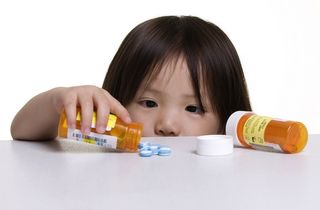Thousands of Kids Hospitalized Every Year After Ingesting Parents' Meds

Every year, more than 34,000 U.S. children go to the emergency room for accidentally ingesting prescription drugs, such as opioid painkillers and anti-anxiety pills, a new study finds.
Some 9,500 of these kids get hospitalized due to the ingestions, the researchers added.
Twelve medications account for nearly half of these hospitalizations, the researchers found. Opioids and benzodiazepines (commonly used for reducing anxiety) are the medication types that most commonly send children to the hospital, according to the study.
The researchers based their estimates on data from a surveillance program that included 63 U.S. hospitals. They looked at the yearly rates of emergency room visits and hospitalization for unsupervised prescription-drug ingestions among children younger than age 6 between 2007 and 2011.
About three-quarters of the hospitalized kids were between the ages of 1 and 2, according to the study, published today (Sept. 15) in the journal Pediatrics. [9 Weird Ways Kids Can Get Hurt]
The new findings show that despite efforts to make drug packaging "child-resistant," accidental ingestion of these drugs by children still remains a serious concern, the researchers wrote.
Studies in the past few years have shown that the number of children going to hospitals after ingesting parents' medication has been increasing, and that prescription drugs (as opposed to over-the-counter medications) account for more than half of these emergency room visits.
Sign up for the Live Science daily newsletter now
Get the world’s most fascinating discoveries delivered straight to your inbox.
Such accidents often happen when people don't fully secure child-resistant caps of medication bottles or leave the medications somewhere children can get ahold of them.
Enhancing the safety of medication packaging could reduce the risk these drugs pose to children, but it may be an inconvenience for adults and add some cost, the researchers said. Therefore, it could be beneficial to prioritize the enhancement of safety packaging on the medications that are most commonly involved in these incidents among children, the researchers said.
In the study, the researchers found the medication most commonly responsible for hospitalization was buprenorphine, an opioid medication used to treat opioid addiction. Buprenorphine was involved in 7.7 percent of the cases of hospitalization. Another drug, clonidine (used to treat anxiety disorders and some addictions) was responsible for 7.4 percent of the hospitalizations. These two drugs, along with 10 others — including oxycodone (an opioid painkiller), bupropion (used to treat depression and help people quit smoking) and clonazepam (used to treat anxiety) — accounted for 45 percent of the hospitalizations.
There are several possible ways to enhance the safety of drug packaging, the researchers said. For example, adding flow restrictors to the tops of liquid medication bottles limits the amount of medication children can drink if they do get ahold of the medication. For solid medications, in one safety approach, called unit-dose packaging, each dose of the drug is stored in child-resistant packages, which could reduce the risk that patients forget to resecure the cap, the researchers said.
Email Bahar Gholipour. Follow Live Science @livescience, Facebook & Google+. Originally published on Live Science.

